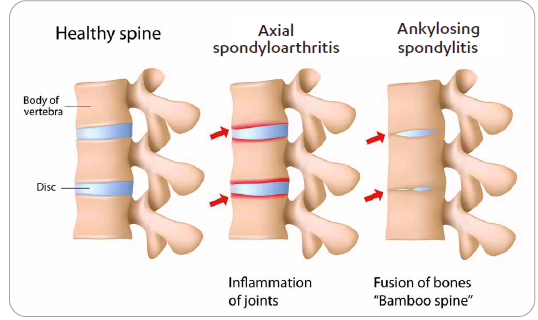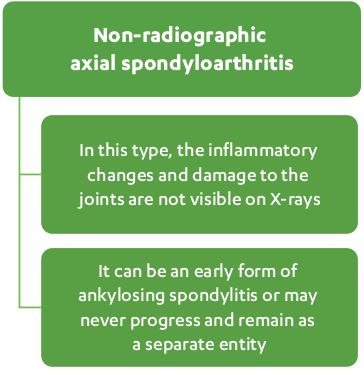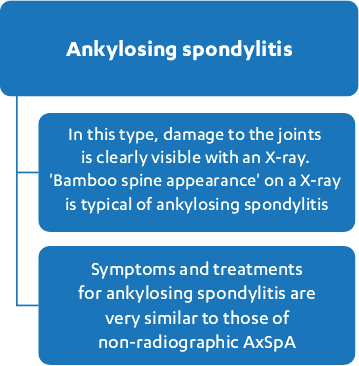WHAT SHOULD ONE KNOW ABOUT AXIAL SPONDYLOARTHRITIS?
Axial spondyloarthritis (AxSpA) is a type of arthritis that is associated with chronic inflammatory changes in the spine and sacroiliac joints (which connect the lower spine to the pelvis). Chronic lower back pain is one of the typical symptoms of AxSpA. It is different from the mechanical type of back pain which one usually gets after an intense workout, or with intervertebral disc problems, or ligament strains. AxSpA is a progressive and often debilitating condition that can severely hamper day-to-day activities if left untreated.

There are two main types of AxSpA depending on the severity of joints affected:


Why does this disease occur?
AxSpA occurs when the body’s immune system malfunctions and produces inflammatory substances that attack its own tissues such as spinal and sacroiliac joints. This leads to chronic inflammation causing symptoms such as pain and stiffness in the lower back and surrounding areas.
Several factors are associated with AxSpA such as:
SPOT THE SYMPTOMS
What are the typical symptoms?
Swelling and back pain in AxSpA has some exceptional characteristics that, when experienced together, can help doctors establish the diagnosis. These include back pain that:
Starts before the age of 40 years
Lasts for at least three months (can be on and off)
Feels worse in the morning, gets better during the day
Improves with activity, exercise and worsens with rest
Subsides by taking painkillers
Often occurs with alternating buttock pain
Often occurs with limited spinal flexibility; for e.g. bending down and putting on socks seems difficult
Let's understand few terms associated with axial spondyloarthritis
AxSpA flare-ups: Symptoms can become worse for short periods called flare-ups.
Remission: It is that period when symptoms get better.
Predicting AxSpA flare-ups can be difficult, but their frequency can be reduced, and long-term damage to the joints can be prevented with suitable treatment.
WHAT IF AXIAL SPONDYLOARTHRITIS IS NOT TREATED ON TIME?
Without timely treatment, AxSpA can gradually worsen and cause the vertebrae of the spine to fuse together. As the condition progresses, unchecked and uncontrolled inflammation can contribute to other complications that can further affect a patient’s life. These complications include:
Severe Pain
Untreated chronic inflammation causes severe pain that can interfere with a person's day-to-day activities and significantly hamper their quality of life.
Reduced Flexibility
Unchecked and progressive inflammation often results in limited mobility of the affected joints and may even cause them to fuse together.
Reduced movement further aggravates stiffness in the spine and can restrict simple day-to-day activities.
Tiredness
A lot of energy expenditure occurs as the body fights chronic inflammation in the joints. This can leave a person feeling drained of energy and cause fatigue.
Tiredness in AxsPA can also be attributed to certain infllamatory substances called cytokines that are circulating in the body on account of the ongoing joint inflammation.
AxSpA may also lead to other issues such as:





HOW IS AXIAL SPONDYLOARTHRITIS MANAGED?
When to visit a doctor?
One should visit a doctor in case of:
Persistent lower back pain
Stiffness in the back (especially in the morning) which gets better with movement and exercise
Redness or swelling in the eye, or unusual sensitivity to light
What should one know regarding the diagnosis of axial spondyloarthritis?
To arrive at the right diagnosis, a doctor may ask many questions about medical history, symptoms, etc.
and may ask to get some blood tests and joint scans done.
Goals of axial spondyloarthritis treatment

What does the treatment include?
Below are a few treatment approaches for treating AxSpA. The specialist will recommend and prescribe a suitable treatment based on the stage and severity of a person’s condition.

Physical therapy and exercise
To help increase the range of motion and muscle strength

Medications
To help relieve pain, prevent or slow down joint damage, to ease difficulties in performing day-to-day activities

Surgery
Based on the disease severity, a doctor may recommend surgery to reduce pain and correct deformities




